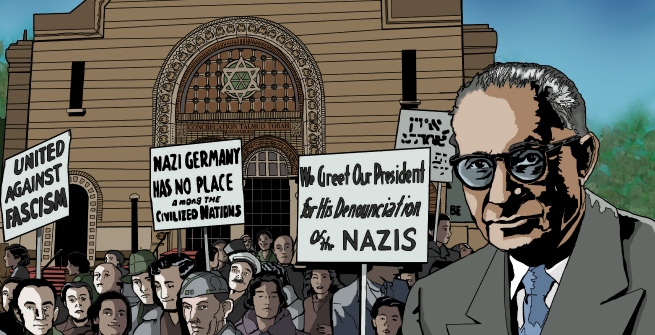Julius Levitt (1885–1952) was a promoter of Yiddish culture and a community activist, most importantly through the Jewish Labor Committee (JLC) to bring attention to the horrors of Nazism throughout the world. Levitt was a member of The Workers Circle, a Jewish nonprofit organization that promotes social and economic justice; a correspondent and manager of the Los Angeles office of the Yiddish newspaper Jewish Daily Forward; and a supporter of local Yiddish authors and book publishing.
In early 1935, Levitt helped establish and was the founding president of the Los Angeles chapter of the Jewish Labor Committee (JLC), a national organization formed to combat Nazism and also advocate for Jewish culture, socialism, and unionism. Under Levitt’s leadership role, the Los Angeles chapter of the JLC was one of the earliest groups to bring forth warnings of the growth of Nazism and anti-Semitism in Germany. One of the group’s early protests focused on the Jewish holiday of Passover in 1937, asking people to boycott purchasing items made in Germany.
The world looked upon in horror as Nazism expanded in Germany. On November 10, 1938, in Germany, Nazi storm troopers looted Jewish-owned stores, burned synagogues, and beat people in the streets. Known as Kristallnacht, or Night of Broken Glass, this event was a precursor to the genocide of European Jews during World War II.
The Los Angeles Chapter of the JLC focused its activism on a two-pronged approach. Yiddish-speaking immigrants focused on resettling Jewish refugees and sending supplies and Yiddish books to those in Europe; the American-born children sought alliances with the non-Jewish communities to bring awareness to the horror of Nazism.
In November 1938, to protest Kristallnacht and honor its victims, the Los Angeles Chapter of the JLC with the United Anti-Nazi Conference and other organizations staged an interfaith march in Boyle Heights. Some 10,000 to 15,000 people of all different races and backgrounds marched down Brooklyn Avenue (now Cesar Chavez Avenue).
By allying with other civil rights groups, such as the NAACP and the Congress of Spanish Speaking Peoples, these organizations also hosted public speeches, aided in the resettlement of refugees, raised funds for Nazi victims, and emphasized that the Nazi threat was not only to Jews but also to other minorities.
Despite the anti-Nazi efforts of Levitt and many other activists, the United States did not enter into World War II until after the attack on Pearl Harbor on December 7, 1941.
Approximately six million Jews died in the Holocaust and this horrific act depleted Yiddish speakers, writers, and thinkers. The International Languages Department has a Yiddish language collection with items dating back to 1859; one item is a Haggadah, a religious text that sets the order for the Passover meal. Of particular note, the collection in International Languages has a large number of Yizkor, or Memorial books, books published to commemorate Jewish life prior to the Holocaust.
In this coloring page created by the Octavia Lab, Julius Levitt and anti-Nazi protestors are pictured in front of Breed Street Shul, also known as Breed Street Synagogue and once the home of Congregation Talmud Torah of Los Angeles. The Breed Street Shul was an Orthodox Jewish synagogue in the Boyle Heights neighborhood. From 1915 to 1951, it was the largest Orthodox synagogue west of Chicago and during that time became the center of Jewish community life in Boyle Heights. During the postwar era, as the area’s population shifted and congregants moved to other parts of town and joined new synagogues, Breed Street Shul began falling into disrepair. In 2000, the Breed Street Shul Project acquired the site to rehabilitate the landmark and transform it into a center of arts, culture, and education whose mission is to serve the needs of its current neighbors.
In 2021, there was activism on the Boyle Street Neighborhood Council to commemorate the work of Levitt with a naming of the area around St. Louis Street just north of 1st Street to Julius Levitt Square. This place is the historical location of the Vladeck Center, a significant community center for The Worker’s Circle and other Yiddish-focused organizations.


